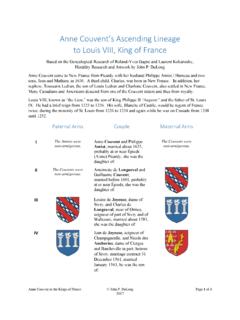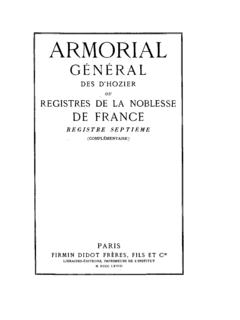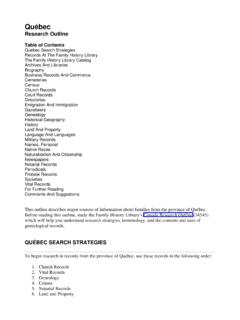Transcription of French Canadians in the Copper Country.ppt - habitant.org
1 French Canadians in the Copper CountryJohn P. DuLongFrench canadian Heritage Society of 3 July 2008 Thank You I would like to thank Luanne Hamel for making the arrangements for me to speak to you today And I would like to thank Chassell Heritage Center for inviting me to speak today I deeply regret that I will not be in Chassell for your French - canadian festival in August, I am sure it will be a grand eventNotes and PowerPoint SlidesA summary of this talk and the PowerPoint slides can be found by pointing your Internet browser to: Canadians Copper The mission today is to put the French Canadians of the Copper Country into a historical perspective The Copper Country French Canadians were an important part of the second wave of immigration to Michigan from Qu becWaves of French canadian Immigration to Michigan There was actually two separate and distinct waves of immigration to Michigan Little interaction between the two waves except in the Detroit area Many people of French canadian ancestry in the state descend from the second wave of immigrants This is especially the case in the Copper CountryComparison of First and Second Waves of French Canadians 1660-1796 Colonial period Fur trade Voyageurs and coureurs des bois Close ties to Indians Single men.
2 Taking native brides Numbered in hundreds 1840-1930 Industrial age Lumberjacks and saw mill workers Surface mine workers Came with wives and children Came over in thousandsComparing Settlements Sault Ste. Marie, 1668 St. Ignace, 1671; Michilimackinac, 1712; and Mackinac Island, 1780 St-Joseph (Niles), 1688 Detroit, 1701 Frenchtown (Monroe), 1785 LP: Grand Rapids, Grand Haven, Muskegon, Ludington, Manistee, Cheboygan, Alpena, Tawas City, Midland, Bay City, and Saginaw UP: Menominee, Escanaba, Ishpeming, Negaunee, Marquette, Houghton, Lake Linden, and CalumetMichigan s Copper Country On the Keweenaw Peninsula, on the far north western end of the Upper Peninsula Consists of Keweenaw, Houghton, and Ontonagon Counties (Baraga County is sometimes included) A Copper mining district from the 1840s to the 1960s Heyday from 1865 to 1913A Land of Immigrants Immigrants were needed to labor in the mines and surface facilities French Canadians were just one of the many ethnic groups They were neighbors with Cornish, German, Irish, Finnish, and many other ethnic groups The immigrants out numbered the YankeesUnfair Advantage With the exception of the Finns and other Scandinavians, we French Canadians had a competitive advantage The winters of Qu bec prepared us for the Copper Country wintersOrigins in Qu bec of Nineteenth Century Immigrants Tended to come from western Qu bec.
3 Near Montr al and along the Ottawa River These are also the same areas that were most heavily involved in the fur trade Often involved in lumbering trade in Canada or eastern United States before immigrating to MichiganStops Along the Way Many French Canadians did not come directly from Qu bec to Canada Many went to work in the textile mills of New England They would come either from New England to Michigan or go back to Qu bec and then come to Michigan Some went to Illinois or Wisconsin firstCivil War Interruption Although some French Canadians came over to Michigan after the failed 1838 Patriot's Rebellion Most did not come until after 1840 But the Civil War put a temporary hold on immigration Some French Canadians served the Union during the Civil War, but more went back to Qu bec during the war Immigration to the Copper Country from Qu bec did not start in earnest until after the Civil WarWork in the Copper Country French canadian men were attracted to the area to work as lumberjacks, carpenters, surface workers at the mines, stamp mill workers, and smelter workers Few worked inside the mines There were few work opportunities for French canadian woman except running boarding housesRoutes to Michigan Before 1855, some still took canoes and small boats After 1855 and the opening of the St.
4 Mary s Falls Ship Canal, they were more likely to take sailing and steam ships By the 1870s they would have used railroads to reach most points However, Houghton was not connected to Marquette by rail until 14 November 1883! The railroads and ships also permitted visits back home to Qu becPush and Pull Pushed out by few industrial opportunities and less agricultural land opening up in Qu bec Pulled to work in the lumber and mining industries Immigration slowed with the stricter laws of the 1920s and nearly stopped with the Great Depression of the 1930sRole of Joseph Gr goire Joseph Gr goire was from St. Valentine, Qu bec Immigrated to the Copper Country in the mid-1850s In 1867 he established on the shores of Torch Lake the hamlet of Gregoryville, a suburb of the village of Lake Linden From this location he operated a sawmill, which made lumber, doors, sashes, and blinds He was the premier French - canadian businessman in the region According to a plaque at St.
5 Joseph's church, he was known as the Father of the French Canadians of Lake Superior He earned this title because he offered jobs to immigrants from Qu bec Gr goire never married and died childless in 1895; he is buried in Mount Calvary Cemetery outside of Lake Linden Little Canada Although some villages were almost entirely French canadian , in most towns they lived in districts Semi-rural / small towns Called Little Canada or Frenchtown Lake Linden or Hubbell (Frog Pond), They had their own general stores, livery stables, barber shops, and saloons (lots of these)Communities with a French canadian Presence Beacon Hill Calumet Chassell Dollar Bay Edgemere Freda Frenchtown Hancock Houghton Hubbell Hurontown Lake Linden Laurium Mason Osceola Redridge Tamarack Mills1900 Census: Number 1900 census, Michigan, 32,483 foreign-born French Canadians , and 55,314 children Approximately percent of population A dramatic demographic turnover from the 1820's when they were the majority1900 Census.
6 Rank Still the foreign-born French Canadians were the fourth largest ethnic group in Michigan Outnumbered by Canadians , Germans, and English Followed by the Dutch, Irish, Swedes, and Poles1900 Census: Counties The 1900 census shows that 59 percent of the foreign-born French Canadians were living in just eight counties Wayne (4,426), Houghton (3,144), Bay (2,664), Delta (2,637), Menominee (1,892), Marquette (1,765), Saginaw (1,288), and Alpena (1,197)1900 Census: New England and New York Michigan (32,483) was behind Massachusetts (134,416) and New Hampshire (44,420) in the number of foreign born French Canadians But Michigan was ahead of Rhode Island (31,533), Maine (30,908), New York (27,199), and Connecticut (19,174)1900 Census: Midwest Michigan (32,483) had the largest settlement of French Canadians in the Midwest Compared to Minnesota (12,063), Wisconsin (10,091), and Illinois (9,129)1950 Census By the 1950 census there was a large numbers of Poles, Italians, and Russians They pushed the foreign-born French Canadians from the fourth to the ninth largest ethnic group in the stateSecond Wave Challenges Other immigrants and being lost in the shuffle Poverty and discrimination as Catholics Tense labor relations Naturalization and voting Survivanceand assimilationOther Immigrants The first wave had to contend with Indians, French , English, American, Irish, and Scottish neighbors The second wave had a much more diverse ethnic environment, this was especially true in the Copper Country They had to compete with these other ethnic groups for jobs and housingOther Immigrants However, the competition here in Michigan was not as intense as in New England The French Canadians tended to intermarry with Irish, Germans, and Walloons Later they would intermarry with Italians, Poles.
7 And other Eastern Europeans The common thread was CatholicismOther Immigrants: The Irish Love / hate relationship with the Irish Both Catholic, but competed over church politics The Irish were for a centralized church, the French Canadians wanted decentralized national parishes and schools Nevertheless, there was much mixed marriage between between themPoverty According to the 1950 census, French Canadians in comparison to other white ethnic groups, had the lowest income However, they were better off in Michigan than in New England (perhaps due to the automobile industry which attracted a lot of Copper Country migrants during the 1950s) In general, education and the professions were not encouraged initiallyDiscrimination French Canadians in Michigan did not face as much discrimination as other ethnic groups in America Any they did feel was more likely because they were Catholic or because spoke French They were seen as clannish and self-isolating because of their retention of FrenchTense Labor Relations In New England, the French Canadians were known as the Chinese of the Eastern states They were often used as strike breakers, though not so much here in the Midwest Nevertheless, in Michigan they were generally viewed as docile workers and hard to organize Although some French Canadians participated in labor activities in the Copper Country.
8 Many others were neutral or hostile to the labor movementNaturalization The French Canadians in Michigan were slow to naturalize and few went through the process to become a citizen There was even a repatriation movement that was not very successful Most of the first generation and a significant portion of the second generation seemed satisfied with being a resident onlySurvivance The French canadian elite were concerned with the preservation of their language, culture, and faith They believed that it was better for the French Canadians to immigrate to the west than to heathen New England They relied on parishes, schools, newspapers, and societiesEthnic Organizations Parishes: By 1912 Michigan had approximately ten parishes identified as totally French and 23 as partially French Many parishes also had schools Newspapers: Between 1809 and 1919, the French canadian communities of Michigan published thirty-three French language newspapersParishes with a Concentration of French Canadians Church of the Resurrection, Hancock Holy Trinity, Beacon Hill Our Lady of Mount Carmel, Franklin Mine Sacred Heart, Calumet St.
9 Anne, Calumet St. Anne, Chassell St. Anne, Redridge St. Cecilia, Hubbell St. Francis of Assisi, Dollar Bay St. Joseph, Hancock St. Joseph, Lake Linden St. Louis, CalumetEthnic Organizations Social groups and mutual benefit societies provided life, accident, and burial insurance Soci t de Lafayette, the Union des Canadiens-Fran ais Catholique, the Institut Jacques Cartier, and the Association Canado-Am ricaine. Many French Canadians were also in the International Order of Foresters. Soci t de St-Jean-Baptiste The Soci t de St-Jean-Baptiste was the largest and most popular Came to Michigan in 1864 Chapters in Alpena, Calumet, Champion, Detroit, Hancock, Houghton, Lake Linden, Manistee, Marquette, Menominee, Muskegon, and NegauneeSoci t de St-Jean-Baptiste Now there is only one Soci t de St-Jean-Baptiste group left in the Detroit area Most of its members are from Qu becEthnic Celebration F te de St-Jean-Baptisteon 24 June.
10 The French Canadians marked their national holiday with parades, picnics, speeches, and bonfiresFailure to Organize Politically The first wave did get Fr. Richard elected to Congress But both the first and second wave failed to organize politically and become a force on the local scene like the Irish did The organizations of the second wave were split by controversiesAnnexation Controversy The annexation controversy, erupted at the 1869 joint conference of French canadian groups in Detroit, damaged the effectiveness of the Soci t St-Jean-Baptiste M d ric Lanctot, a journalist, spoke at this meeting and argued that Qu bec should break away from the Canada and become part of the United States. Naturalization Controversy The French canadian elite was hesitant to endorse naturalization because of its feared impact on survivance Not until the 1886 national St-Jean-Baptiste convention in Plattsburgh, New York, did they endorse a platform of "naturalization without assimilation"Ironic Turn Against all predictions, the French Canadians in New England have done a better job preserving their culture and language They could easily travel home to Qu bec More often refreshed with new immigrantsAssimilation French Canadians tended to hold on to their language and culture longer than most other ethnic groups However, in another irony, once they assimilated it was almost total Very few French Canadians speak French any more, nor do they listen to their music, only the food ways are leftSeparatism As an example of the distance between French Canadians in Michigan and Qu bec.












